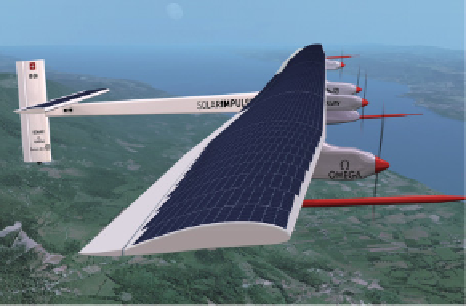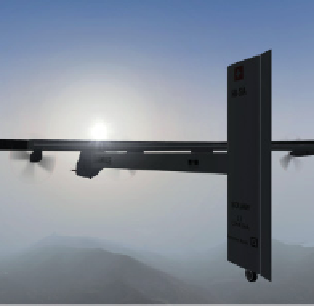Environmental Engineering Reference
In-Depth Information
Five stopovers are planned during the fl ight around the world. Each leg of the
fl ight should take four to fi ve days, which is as much as can be expected from one
pilot. During stopovers the pilot will be changed and promotional activities will be
organized.
With technical advances in batteries and a resulting anticipated reduction in weight,
the aeroplane could be used for longer fl ights with two pilots. This would then
bring a non-stop trip around the world in a solar aeroplane into the realm of
possibility.
Figure 14.16
Bertrand Piccard of Switzerland aims to fl y the aeroplane Solar Impulse round the world
in 2011.
Photos © Solar Impulse/EPFL Claudio Leonardi.
14.4.5 Flying for Solar Kitchens
Based on current technology, it does not seem likely that solar aeroplanes will ever
be able to replace large conventional planes. Even with highly effi cient solar cells,
the space available on the surface of the wings is not large enough to provide suf-
fi cient driving energy for planes carrying loads of several hundred tons. With the
exception of a very limited possible use of biofuels, there are no options offering
complete climate-compatible air travel. In the long term renewably produced hydro-
gen offers an alternative to fossil fuels.
Until then the only carbon-free alternative available is no air travel at all. Modern
communication technologies and more and more interesting leisure activities in
close proximity to where people live are helpful alternative options to travel. But
the solarium around the corner is not really a substitute for a winter break in a sunny
resort. It makes it even more diffi cult to stick to one's principles if cheap fl ights are
offered at the same price as a ticket for the local city train.
Section 3.5 of this topic showed that, as an interim solution, investments in other
areas can reduce as much carbon dioxide as created by an unavoidable fl ight. The
carbon dioxide emissions of a fl ight from Berlin to New York and back can be
offset for around 100 euros. As part of its programme, the non-profi t company
Atmosfair offers measures designed to compensate for emissions and at the


